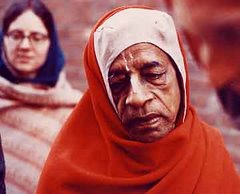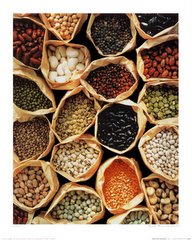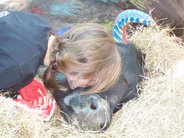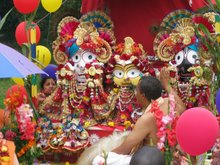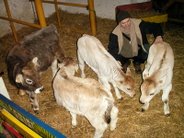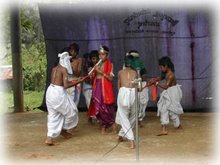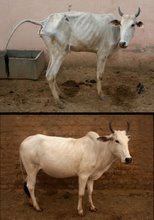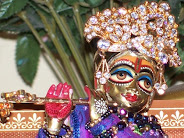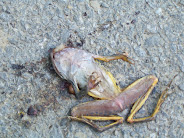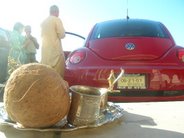Thursday, August 23, 2007
Leadership in Energy and Environmental Design
What is LEED®?
The Leadership in Energy and Environmental Design (LEED) Green Building Rating System™ is the nationally accepted benchmark for the design, construction, and operation of high performance green buildings. LEED gives building owners and operators the tools they need to have an immediate and measurable impact on their buildings’ performance. LEED promotes a whole-building approach to sustainability by recognizing performance in five key areas of human and environmental health: sustainable site development, water savings, energy efficiency, materials selection, and indoor environmental quality.
LEED provides a roadmap for measuring and documenting success for every building type and phase of a building lifecycle. Specific LEED programs include:
New Commercial Construction and Major Renovation projects
Existing Building Operations and Maintenance
Commercial Interiors projects
Core and Shell Development projects
Homes
Neighborhood Development
Guidelines for Multiple Buildings and On-Campus Building Projects
LEED for Schools
LEED for Retail
USGBC is also developing LEED for Healthcare, and LEED for Labs.
We also have the LEED Resources page which has informative PowerPoint presentations, brochures, and case studies, as well as LEED News and LEED-Online sample credit templates.
How is LEED Developed?
The LEED Rating System was created to transform the built environment to sustainability by providing the building industry with consistent, credible standards for what constitutes a green building. The rating system is developed and continuously refined via an open, consensus-based process that has made LEED the green building standard of choice for Federal agencies and state and local governments nationwide. Click here for more information on the LEED Development Process.
What is LEED Certification?
The first step to LEED certification is to Register your project. A project is a viable candidate for LEED certification if it can meet all prerequisites and achieve the minimum number of points to earn the Certified level of LEED project certification. To earn certification, a building project must meet certain prerequisites and performance benchmarks ("credits") within each category. Projects are awarded Certified, Silver, Gold, or Platinum certification depending on the number of credits they achieve. This comprehensive approach is the reason LEED-certified buildings have reduced operating costs, healthier and more productive occupants, and conserve our natural resources.
Note for Product Manufacturers and Service Providers:
Although USGBC does not certify, promote, or endorse products and services of individual companies, products and services do play a role and can help projects with credit achievement. (Note that products and services do not earn projects points.) Learn more here about how you and your company can help advance green building, while also achieving your own environmental and economic goals.
Who Can Use LEED?
Everyone: Architects, real estate professionals, facility managers, engineers, interior designers, landscape architects, construction managers, lenders, government officials...
The LEED program also includes a full suite of training workshops and a Professional Accreditation program to develop and encourage green building expertise across the entire building industry.
Questions?
Visit the LEED Help section of our website.
Wednesday, August 22, 2007
Organic Farming Could Feed the World
Along with reporting on fertilizers, biotech, ethanol, corporate consolidation and the agrofuels vs food debate comes an increased science reporting of the real world of organic-ecological-diversified agriculture that actually feeds the world.
The biotech industry used to regard speed as one of the defining characteristics of genetic engineering. To prove the point, it rushed new products to market with little regard for the consequences. Speed, however, is a characteristic of neither good science nor sustain-able agriculture. Now the 'slow' reports of scientific findings on nutritious food and sustainable agriculture are beginning to surface. It will be interesting to see how the biotech bullies deal with these. The authors of a new study* claim that a switch to organic farming would not reduce the world's food supply but could actually increase food security in developing countries. They claim their findings lay to rest the debate over whether organic farming could sustainably feed the world. The team of researchers has compiled research from 293 different comparisons into a single study to assess the overall efficiency of the two agricultural systems.
They found that in 'developed' countries organic systems produce, on average, 92% of the yield produced by conventional agriculture. In 'developing' countries, however, organic systems produce 80% more than conventional farms. Then, using data from the UN Food and Agriculture Organization, the team estimated what would happen if farms world-wide were to switch to organic methods today.
The researchers found that under an organic-only regime, farms could produce between 2641 and 4381 calories per person per day compared to the current world equivalent of 2786 calories per person per day. Members of the team believe the calculations they carried out to arrive at the upper number are the most realistic. These took into account the higher yields that would be obtained in developing countries, and the details of which crops are grown where. Nutritionists recommend that people consume between 2100 and 2500 calories a day.
The researchers found that small farms tend to produce more per hectare of land. They also note that although organic production tends to require more labour, this labour is often spread out more evenly over the growing season, making it easier to manage. They also point out that once you incorporate the environmental costs, then organic agriculture is a much superior system.
In this era of climate change and unpredicted disasters (droughts, floods, heat waves, etc.) organic/ecological agriculture has another important virtue. Relying on locally-sourced and adapted species and varieties as well as labour, knowledge, and skills, it is much more resilient than a system which is dependent on manufactured and imported inputs.The issue of speed is also crucial. As George Monbiot has persuasively argued, air travel may be the single most intractable cause of carbon emissions. But fast boats, trains, and cars are also problematic. The fact is that when you take the whole system into account, speed is simply not efficient. Slower modes of transport would, of course, limit the perishable food and other products which are now shipped around the globe, and make us all more dependent on what we can produce ourselves. Not a bad idea.
* Organic agriculture and the global food supply: Catherine Badgley, Jeremy Moghtader, Eileen Quintero, Emily Zakem, M. Jahi Chappell, Katia Avilés-Vázquez, Andrea Samulon and Ivette Perfecto, Renewable Agriculture and Food Systems, 2007, Cambridge University Press
Tuesday, August 21, 2007
Is local the new organic?
Last week, The New York Times ran a feature by Marian Burros on New Seasons Markets, a grocery store chain in Portland that's banking on consumer interest in local, sustainable food -- as opposed to simply organic.
The chain recently completed an inventory of the origins of its stock and has labeled everything grown in Oregon, Washington, and Northern California "Homegrown." They've already got six stores and three more on the way, but remain adamantly opposed to expanding beyond the Portland suburbs -- a testament to their commitment to being grounded in the local food economy.
People concerned about health, taste, and the environment have long sought out organic products. Once a cutting-edge concept for gourmets and health-food junkies, organic is now mainstream, with many familiar major food brands launching organic product lines. I bought organic milk at a Seattle Safeway the other day that was packaged under Safeway's own new "O" label. Organics are the fastest growing segment of the food industry, with sales increasing by some 20 percent per year.
But, as the NYT piece notes, organic alone is not the answer to the question of the fundamental role food plays in our local economy, environment, food security, community vitality, or even health and enjoyment. I don't know where that organic milk I bought from Safeway came from. I like the idea of sticking with my delivery from Smith Brothers dairy each week. Even though it's not organic, there's no growth hormone used and I am supporting the last of the independent dairy farms in my state, Washington.
We won't be seeing New Seasons outside the Portland area any time soon -- but other areas are making progress on the local food front.
In the Seattle area, for example, cutting-edge projects are exploring food as a driver in the local economy and as a focal point for public policies ranging from health and nutrition to urban planning and even transportation.
Sustainable Seattle is launching a first-of-its-kind research project looking at how dollars spent on locally produced food affect the local economy, as a counterpoint to the dollar spent on the average grocery item that has traveled 1500 miles to reach the consumer.
Washington State University's King County Extension office is leading an effort to establish a food policy council for Seattle and King County that would bring together a broad spectrum of food system participants -- from farmers to hunger activists to grocery executives to land use experts -- to work jointly on solutions to current challenges like childhood obesity, disappearing farmland, and alarmingly high levels of hunger in our community.
I have always believed in the power of coming to the table together to hash out issues, find common ground, and be reminded of one another's humanity, but I have most often thought about it in the very personal context of family and friends. In these times of bitter division, can coming to the table in celebration of delicious local-grown bounty help remind us of our many shared values and experiences?
Saturday, August 18, 2007
Does Krishna Like Milk From Unprotected Cows?
I just read this article on Dandavats and it encouraged me to hurry up and write an article that I’ve been wanting to write for a long time. Most of the information in this article is from Peta, the vegan society, and http://www.milksucks.com/ (I know, not a nice name, but they have some good info).
One of the first things I heard when I met the devotees was “you can’t be a vegan devotee.” This is because Krishna loves milk and milk products and devotees love to offer them to him.
The problem is that the milk we (in the cities) are offering to Krishna is not pure. As Jahnava mataji said last Saturday, actually all foods in Kali Yuga are considered to be impure.
Krishna doesn’t just love milk, Krishna loves cows. So how does he feel if we are offering him grocery store milk that is laden with antibiotics and growth hormones—milk that comes from cows that are abused and mistreated and finally sent to the slaughterhouse?
To give milk the cow must be pregnant and then have a calf. On both organic and non-organic farms, cows are kept continuously pregnant. On non-organic farms mother cows are treated like machines, chained by their necks in concrete stalls for months at a time, their udders are swollen so large that they sometimes drag on the ground. Cows give milk for the same reasons humans do—to feed their babies. To keep milk production high, cows are kept pregnant by artificial insemination and their male calves are taken away at 1-2 days old and chained inside cramped dark crates to be killed for veal. The milk meant for them is what we buy on the grocery shelves. They are not even given a chance to drink their mother’s milk.
It is too easy to turn a blind eye to what goes on behind the grocery store shelves. After all, how can we not offer milk sweets to Krishna? How will the Sunday feast go on without sweet rice?
But how can we offer milk sweets to Krishna using milk that (unless organic) contains hormones, antibiotics, disease, blood, fish and who knows what else? Cows are so dear to Lord Krishna that I just cannot imagine he would want to taste milk from cows so horribly abused, or even if not abused (organic cows), nevertheless sent to the slaughterhouse.
The ideal is, as Sivarama Swami says, to support the Iskcon farms in their efforts to protect the cows and offer pure milk to Krishna. But for those of us who live far from farms and must buy milk from the store, it seems that abstaining from milk products is the only choice. A vegan diet is the only option for cow protection living in the city.
Find the full article at http://namahatta.org/nh2/en/node/5535
Friday, August 10, 2007
Thoughts on Shambo the Bull and Other Sacred Animals.

Article from The Vaishnava Voice
It seems like everyone wants to read about Shambo the bull. My blog visitor numbers have never been so high. Even at the London Rathayatra festival on Sunday, people were asking us: “Is this a protest march for Shambo?”
The story of Shambo the bull is of course a sad tale. Despite last minute sea changes in the legal decisions, and despite much public sympathy, 20,000 signatures and a hundred sitting in protest at the temple in Wales, Shambo was ultimately taken away to be killed.
His plight, and the plight of those trying to save his life, was not really sympathised with by certain journalists. Reading the situation as being one of sentimental monks fretting about their pet bull, they castigated them for not seeing the relative importance of a ‘pet animal’ when compared to the health of other cows or indeed of humans who might catch TB.
Other writers, catching the fundamentalist fatigue in the British public, noted that here was another case where one groups eccentric religious laws were meant to be pandered to at the expense of us all. Other farmers have had their herds culled due to TB infection, and many other farmers lost their entire herd to foot and mouth disease within recent years. They were also troubled by their loss but ultimately had to do the decent thing and surrender them for slaughter. Why so much fuss about one “sacred” bull?
They’re missing the point. Shambo was sacred not because he was a bull living in a temple. And he was not sacred because some Hindu monks had designated him as such. And he was not sacred because he was a Hindu bull. As bulls go, Shambo was no more or less sacred than any other bull happily grazing in any field.
All bulls, cows, and indeed all life, is worthy of our reverence and protection. The world’s oldest scripture calls upon us to see a spark of the Divine in all beings, and especially in those animals which have been designated by God to provide for our existence in some way. Through them, we come to see our connection to the Divine and how we are cared for. The Skanda Vale temple just happened to be one of the few places in the country where this approach to the sanctity of life was honoured and practised. And Shambo - for a few brief years - just happened to be on the receiving end of such vision and generosity.
Perhaps we have all participated in bringing about the natural catastrophes that now threaten farmers everywhere. Incessant demand for meat and increased milk yield have turned our four-legged mothers and fathers into walking bags of hormones and antibiotics. Who knows what natural bovine immunities become extinct after generations of this treatment?
Ultimately the Vedas explain that ahimsa or non-violence is the path that human beings are meant to tread if they wish to make progress on the upward path. The repercussions of this choice will restore nobility to our increasingly violent society and safeguard us all. And non-violence begins with our tongue; not hurting others with our words, and not hurting others with our choice of food.
This was written a few centuries ago by Thiruvalluvar, an Indian poet, in his book Thirukural or Sacred Couplets :
How can he practice true compassion
who eats the flesh of an animal to fatten his own flesh?
Riches cannot be found in the hands of the thriftless,
nor can compassion be found in the hearts of those who eat meat.
He who feasts on a creature’s flesh is like he who wields a weapon. Goodness is never one with the minds of these two.
If you ask, “What is kindness and what is unkindness?”
It is not-killing and killing. Thus, eating flesh is never virtuous.
Life is perpetuated by not eating meat.
The jaws of Hell close on those who do.
If the world did not purchase and consume meat,
no one would slaughter and offer meat for sale.
When a man realizes that meat is the butchered flesh
of another creature, he will abstain from eating it.
Insightful souls who have abandoned the passion to hurt others will not feed on flesh that life has abandoned.
Greater than a thousand ghee offerings consumed in sacrificial fires is to not sacrifice and consume any living creature.
All life will press palms together in prayerful adoration
of those who refuse to slaughter or savour meat.
Sunday, August 5, 2007
What Are You Doing for Cow Protection?

By HH Sivarama Swami
Krsi goraksya vanijya. Krsi means ploughing or agriculture and goraksya, cow protection. These are the staples of society, this is what people live on. All living entities subsist on grains. So the ksatriyas may direct and instruct people, the brahmanas may perform their yajnas, but if they don’t eat then giving shelter or instruction is not going to work.
That eating is therefore the most essential aspect of life and this is why the vaisyas and their assistants, the sudras, are so integral that the other castes think that they are the most important people, because it is actually they who are feeding. Of course the vaisyas think that the brahmanas are the most important because they are taking the result of their work and offering it back to the Lord.
Srila Prabhupada said that this very common type of exchange was there but the responsibility of this goraksya, is it the duty of just some people? Some very very exclusive people? Is it the responsibility of all vaisyas, or is it for all grhastas or all devotees?
My proposition is that it is everyone’s responsibility. Just like everyone’s responsibility is chanting Hare Krishna, watering Tulasi devi, reading Bhagavatam. Similarly part of our common dharma is to protect cows. This is something that you see ingrained in communities like Bhaktivedanta Manor, where they have to limit the amount of cows they receive as gifts, and be very careful about the type of food that is offered to the cows, because to a greater or lesser degree all the devotees see the protection of cows as their dharma.
It is everyone’s dharma: the cow is our mother, she gives us milk while all over the rest of the world cows are being butchered, slaughtered, abused, and taken advantage of. Vaisnavas must take it as their responsibility to protect cows. Now, how do you protect cows? Does that mean that you have a cow on your balcony in downtown Singapore? No, that type of cow protection is actually cow abuse. You cannot just keep your own cow.
Cows only give milk if they have calves, which means you have to constantly have calves, which means you have to have a herd, and that is a full time business. So how is it that individuals should protect cows? They should in some way or another be connected to ISKCON’s herds. Srila Prabhupada established cow protection for instance in New Vrindavan, Gita Nagari, or as we have done here in Hungary at New Vraja-dhama. These herds are not the sole responsibility or duty of the local devotees in those places, they are the responsibility of the devotees and congregation of the local country. It is their responsibility to contribute to the cow protection, to donate towards the maintenance of the cow, to come and do some cow seva, and when they come to the temple they should bring some bhoga for the cows, to find out what items are needed by the cowherds. And the cow herds.
Cow protection is everyone’s business, it is everyone’s responsibility. This is being written down as varnasrama dharma. If one does not contribute or participate directly in cow protection then he should know that he is neglecting his dharma, he is neglecting his dharma. In other words he is adharmic.
This is in my view the greater picture of what varnasrama means. Varnasrama doesn’t mean that we simply philosophise about a way of life, but what are the duties of varnas and asramas, what are the duties that are common for all Vaisnavas, for all humans. And one of them is the protection of cows, just like chanting Hare Krsna is a common responsibility as mentioned earlier.
So, similairly, cow protection is a common responsibility for everyone. It doesn’t necessarily always occur to us, and even when it does, it’s difficult to get devotees interested. More difficult than getting devotees to do sankirtan, more difficult than getting someone to cook in the kitchen or be temple president, is to get devotees to be cowherds. To make devotees work with the cows, bulls, and oxen and to make that their life, it is very difficult for devotees to do this. “I am an educated person, I have this diploma and you want me to take care of cows? You want me to do that thing that God does? You want me to do that activity that is going on in the spiritual world?”
And that is what is going on the spiritual world. That is what is going on where we are going–at least where I want to go is where there is only gopas and gopis. The whole social identity is based on go, on cows. There are milkmaids and there are cowherd men. And if we are not willing to be milkmaids and cowherd men here in the material world, if this service is beyond us and we cannot forsee how we are going to dedicate our lives to working with the cows, then were are we going? Then you had better look for somewhere other than Braja. Then you had better go to Dwaraka or Vaikuntha, where that is not a compulsory, integral part of life.
Because in the spiritual world, in Goloka Vrindavan, Krishna goes out every day to tend cows. And yet it is so difficult to get devotees to be cowherders, to see that this is a respectable future, and to stick with that service. Because once again, cow protection is something that we talk about as being against the principles of slaughtering the animals. We don’t believe in slaughtering the cow, we don’t believe in eating the meat of the cow, cows should be properly protected. But, when it comes to properly protecting the cows, are we willing to do it? Are we actually willing to dedicate our lives to taking care of cows? Or are we willing to participate and support the protection of cows?
Therefore, we should ask: “What am I doing for protecting my mother? What am I doing to sustain cow protection in my zone? It is my responsibility, my duty as a Vaisnava. Am I performing my dharmic duty?”
